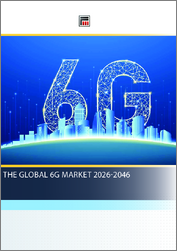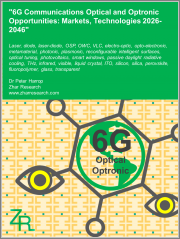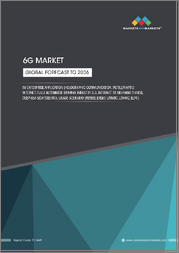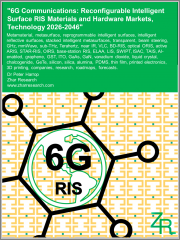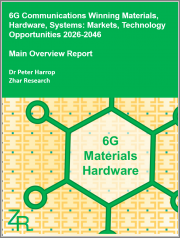
|
시장보고서
상품코드
1587643
세계의 6G 시장 예측 : 컴포넌트별, 전개 디바이스별, 기술별, 용도별, 최종 사용자별, 지역별 분석(-2030년)6G Market Forecasts to 2030 - Global Analysis By Component (Hardware, Software, Services and Other Components), Deployment Device, Technology, Application, End User and By Geography |
||||||
Stratistics MRC에 따르면 세계의 6G 시장은 2024년에 69억 달러로 추정되고, 예측 기간 동안 CAGR은 33.7%로 성장할 전망이며, 2030년에는 397억 달러에 이를 것으로 예상됩니다.
6G(6세대 무선 기술)는 2030년대에는 5G를 넘어 5G의 최대 100배의 속도를 제공할 것으로 예상되고 있습니다. 초저지연, 신뢰성 향상, 전례 없는 데이터 전송 속도를 제공하여 연결성에 혁명을 가져와 순간 통신을 가능하게 합니다. 6G 네트워크는 AR, VR, 메타버스 등 신기술과 AI, IoT의 진화를 지원합니다. 또한 효율적인 에너지 사용, 안전한 데이터 처리, 고급 엣지 컴퓨팅도 가능합니다. 6G는 원격 헬스케어, 자율 시스템, 스마트 시티 인프라에서 중요한 역할을 수행하고 디지털 경험과 세계 및 연결성을 재구성합니다.
에릭슨의 보고서에 따르면 2022년 말 시점에서, 고정 무선 액세스(FWA) 트래픽을 제외한 세계 모바일 데이터 트래픽 총량은 월간 93EB에 이르렀습니다. 2028년까지는 이 트래픽은 3.5배로 증가하고 월간 329EB에 이를 것으로 예상됩니다.
고속 및 저지연 연결에 대한 수요 증가
6G 기술의 연구개발비는 신뢰성이 높고 보다 빠른 접속성의 필요성에 의해 추진되고 있습니다. 이러한 수요를 충족시키기 위해, 기업이나 학술 기관은 독창적인 솔루션을 내놓고, 네트워킹의 인프라나 기술을 진보시키고 있습니다. 또한, AR, VR, 무인 운전 차량, 실시간 원격 감시 등 고속 저지연 접속에 의해 가능해지는 새로운 애플리케이션으로 경쟁 우위를 위한 6G에 대한 관심이 높아져 시장의 성장을 뒷받침 하고 있습니다.
높은 개발 및 전개 비용
경쟁의 감소와 혁신의 감소는 신규 경쟁업체에 심각한 장애가 되는 높은 통신 시장 비용으로 인해 발생할 수 있습니다. 이는 연결 솔루션의 개발을 방해할 수 있습니다. 6G 시장 개척에 투자하기 위해서 통신 사업자는 다른 중요한 이니셔티브로부터 자금을 철회해야 할 수 있으며, 이는 전체 사업 계획에 영향을 미치고 인프라 업그레이드 및 5G 개선과 같은 다른 분야의 성장이 6G 시장을 방해합니다.
데이터 집약적 용도에 대한 의존성 증가
6G 기술은 AR, VR, 실시간 데이터 분석 등 데이터 집약적 애플리케이션의 고대역폭 요구 사항에 대응하여 개발되었습니다. 더 높은 데이터 속도와 효과적인 대역폭의 이용이 이 기술의 목표입니다. 나아가 신뢰성 높은 연결성과 저지연을 제공하기 위해 6G는 에지 컴퓨팅, 분산 안테나 시스템, 초스몰셀 등의 네트워크 인프라 개선을 요구하고 있습니다. 이 때문에 6G는 통신 네트워크 발전에 매우 중요합니다.
고주파 대역의 기술적 과제
6G에서 상정되는 고주파 대역은 전파의 도달 거리가 짧고, 감쇠나 장애물이 발생하기 쉽기 때문에 지방이나 인구밀집지에서는 커버리지 갭이 발생합니다. 특히 농촌이나 인구밀집지역에서는 이러한 네트워크 설계의 복잡성이 계획과 도입의 기간을 장기화시킬 수 있으며, 6G의 도입 속도가 둔해져 시장의 진보를 방해할 수 있습니다.
COVID-19의 영향 :
COVID-19의 대유행은 6G 시장에 큰 영향을 주어 공급망의 혼란과 노동력의 제한에 의한 연구 개발의 지연을 일으켰습니다. 원격근무로의 전환이나 디지털 서비스에 대한 의존도의 증가가 고도의 연결성에 대한 수요를 높이는 한편, 기업이 당면한 운영 요구를 우선적으로 6G 프로젝트에 대한 자금제공은 정밀조사에 직면했습니다. 하지만 이 위기는 이해관계자들이 회복력 있는 통신망의 중요성을 인식했기 때문에 차세대 기술에 대한 관심을 가속화하고 팬데믹 이후 6G 투자와 기술 혁신을 가속시키는 길을 열 가능성도 있었습니다.
예측기간 동안 스마트폰 분야가 가장 빠른 것으로 예측
스트리밍, 게임, 증강현실(AR) 등의 데이터 집약적인 용도에 대응하기 위해 스마트폰에서는 보다 빠르고 신뢰성 높은 연결성에 대한 수요가 높아지고 있습니다. 이러한 성능 강화 움직임은 실시간 홀로그래픽 커뮤니케이션이나 몰입형 가상현실 경험과 같은 새로운 애플리케이션을 가능하게 하는 사용자의 기대에 부응하기 위해 6G 기술 개발을 촉진하고 있습니다.
예측기간 동안 블록체인 분야의 CAGR이 가장 높아질 전망
블록체인 부문은 예측 기간 동안 6G 시장에서 가장 높은 CAGR을 나타낼 것으로 예측됩니다. 이는 블록체인의 비중앙집중적이고 암호화된 특성으로 제공되는 6G 네트워크에서 데이터 변속기에 대한 더 높은 보안, 연결된 장치 및 데이터 플로우의 방대한 확대에 필수적이기 때문입니다. 게다가 6G는 데이터의 무결성을 보증하는 것으로 6G 네트워크의 보안을 향상시킬 수 있어, 이것은 금융거래, 헬스케어 데이터 교환, 자율주행차 통신과 같은 신뢰성과 신뢰성이 필요한 용도에 필요하며 시장을 견인합니다.
최대 점유율을 차지하는 지역 :
북미는 일류 연구기관과 혁신적인 기업을 포함한 강력한 기술 인프라가 갖추어져 있기 때문에 통신 기술의 급속한 진보가 촉진되어 6G 개발에 최적이기 때문에 예측 기간 중 북미가 최대 시장 점유율을 차지할 것으로 예상됩니다. 퀄컴, 인텔, AT&T, 베라이존 등의 대기업은 6G 연구개발에 많은 투자를 하고 있으며, 5G에서 6G 인프라로의 전환을 촉진하고 6G 시장을 더욱 활성화하고 있습니다.
CAGR이 가장 높은 지역 :
아시아태평양은 예측 기간 동안 가장 높은 성장률을 나타낼 것으로 예상됩니다. 이는 아시아태평양 정부가 자금 제공과 전략적 이니셔티브를 통해 6G 개발을 추진하고 있으며, 중국이 연구개발과 Huawei, ZTE 등 통신기업에 많은 투자를 하고 있기 때문입니다. 인도의 Bharat 6G Alliance는 산업계와 학계의 노력을 통합합니다. 이 지역에서는 기술 혁신도 활발해 일본, 한국, 인도 등 대기업이 6G 기술의 연구개발에 많은 투자를 하고 있습니다.
무료 사용자 정의 서비스 :
이 보고서를 구독하는 고객은 다음 무료 맞춤설정 옵션 중 하나를 사용할 수 있습니다.
- 기업 프로파일
- 추가 시장 기업의 종합적 프로파일링(3개사까지)
- 주요 기업의 SWOT 분석(3개사까지)
- 지역 세분화
- 고객의 관심에 응한 주요국 시장 추계, 예측 및 CAGR(주 : 타당성 확인에 따름)
- 경쟁 벤치마킹
- 제품 포트폴리오, 지리적 존재, 전략적 제휴에 기반한 주요 기업 벤치마킹
목차
제1장 주요 요약
제2장 서문
- 개요
- 이해관계자
- 조사 범위
- 조사 방법
- 데이터 마이닝
- 데이터 분석
- 데이터 검증
- 조사 접근
- 조사 정보원
- 1차 조사 정보원
- 2차 조사 정보원
- 전제조건
제3장 시장 동향 분석
- 성장 촉진요인
- 억제요인
- 기회
- 위협
- 기술 분석
- 용도 분석
- 최종 사용자 분석
- 신흥 시장
- COVID-19의 영향
제4장 Porter's Five Forces 분석
- 공급기업의 협상력
- 구매자의 협상력
- 대체품의 위협
- 신규 진입업자의 위협
- 경쟁 기업간 경쟁 관계
제5장 세계의 6G 시장 : 컴포넌트별
- 하드웨어
- 소프트웨어
- 서비스
- 기타 컴포넌트
제6장 세계의 6G 시장 : 전개 디바이스별
- 스마트폰
- 태블릿
- 웨어러블
- 사물인터넷(IoT) 디바이스
- 기타 배포 장치
제7장 세계의 6G 시장 : 기술별
- 인공지능 및 머신러닝
- 블록체인
- 빅데이터 분석
- 양자통신
- 엣지 컴퓨팅
- 센싱 기술
- 기타 기술
제8장 세계의 6G 시장 : 용도별
- 고신뢰성 저지연 통신
- 장거리 고이동통신
- 초대규모 기계형 통신
- 초저전력 통신
- 기타 용도
제9장 세계의 6G 시장 : 최종 사용자별
- 통신 사업자
- 의료 제공자
- 자동차산업
- 정부
- 공공 안전 및 방위
- 제조업
- 기타 최종 사용자
제10장 세계의 6G 시장 : 지역별
- 북미
- 미국
- 캐나다
- 멕시코
- 유럽
- 독일
- 영국
- 이탈리아
- 프랑스
- 스페인
- 기타 유럽
- 아시아태평양
- 일본
- 중국
- 인도
- 호주
- 뉴질랜드
- 한국
- 기타 아시아태평양
- 남미
- 아르헨티나
- 브라질
- 칠레
- 기타 남미
- 중동 및 아프리카
- 사우디아라비아
- 아랍에미리트(UAE)
- 카타르
- 남아프리카
- 기타 중동 및 아프리카
제11장 주요 발전
- 계약, 파트너십, 협업 및 합작투자(JV)
- 인수 및 합병
- 신제품 발매
- 사업 확대
- 기타 주요 전략
제12장 기업 프로파일링
- AT&T
- Broadcom
- Cisco
- Deutsche Telekom
- Docomo
- Ericsson
- Huawei
- Jio
- NEC Corporation
- Nokia
- NTT Docomo
- Orange
- Telefonica
- Vodafone Group
According to Stratistics MRC, the Global 6G Market is accounted for $6.9 billion in 2024 and is expected to reach $39.7 billion by 2030 growing at a CAGR of 33.7% during the forecast period. 6G, or sixth-generation wireless technology, is expected to surpass 5G by 2030s, offering speeds up to 100 times faster than 5G. It offers ultra-low latency, enhanced reliability, and unprecedented data transfer rates, revolutionizing connectivity and enabling instantaneous communication. 6G networks support emerging technologies like AR, VR, and the metaverse, as well as AI and IoT advancements. It also enables efficient energy use, secure data handling, and advanced edge computing. 6G will play a key role in remote healthcare, autonomous systems, and smart city infrastructure, reshaping digital experiences and global connectivity.
According to the Ericsson report, at the end of 2022, total global mobile data traffic, excluding traffic from fixed wireless access (FWA), reached 93 EB per month. By 2028, it is anticipated that this traffic will have increased by a factor of 3.5 to reach 329 EB per month.
Market Dynamics:
Driver:
Growing demand for high-speed, low-latency connectivity
Research and development expenditures for 6G technology are being driven by the need for dependable, quicker connectivity. To satisfy these demands, businesses and academic institutions are coming up with creative solutions, which are advancing networking infrastructure and technology. Additionally, interest in 6G for competitive advantage is increased by the new applications made possible by the high-speed, low-latency connectivity, such as AR, VR, driverless cars, and real-time remote monitoring which boosts the market growth.
Restraint:
High development and deployment costs
Reduced competition and less innovation might result from high telecommunications market costs that provide serious obstacles to new competitors. This could impede the development of connectivity solutions. In order to invest in 6G development, telecom operators could have to take money away from other important initiatives, which would affect their overall business plan and growth in other areas like infrastructure upgrades or 5G refinement hampering 6G market.
Opportunity:
Increasing reliance on data-intensive applications
6G technology was developed in response to the high bandwidth requirements of data-intensive applications such as AR, VR, and real-time data analytics. Higher data rates and effective bandwidth use are the goals of this technology. Furthermore, to provide dependable connectivity and low latency, 6G calls for improved network infrastructure, such as edge computing, distributed antenna systems, and tiny cells. Because of this, 6G is crucial to the development of telecom networks.
Threat:
Technical challenges with high-frequency bands
Coverage gaps occur in rural locations and highly populated areas because high-frequency bands, such as those anticipated for 6G, have a shorter range and are more prone to attenuation and obstruction. Particularly in rural or densely populated areas, this network design complexity may cause lengthier planning and implementation durations, which could slow down the pace of 6G adoption and hinder market advancement.
Covid-19 Impact:
The COVID-19 pandemic significantly impacted the 6G market, causing delays in research and development due to disrupted supply chains and workforce limitations. While the shift to remote work and increased reliance on digital services heightened the demand for advanced connectivity, funding for 6G projects faced scrutiny as companies prioritized immediate operational needs. However, the crisis also accelerated interest in next-generation technologies, as stakeholders recognized the importance of resilient communication networks, potentially paving the way for faster investment and innovation in 6G post-pandemic.
The smartphones segment is expected to be the fastest during the forecast period
Over the estimation period, the smartphones segment is likely to capture the largest market share owing to the demand for faster and reliable connectivity in smartphones is increasing due to their ability to handle data-intensive applications like streaming, gaming, and augmented reality. This push for enhanced performance is driving the development of 6G technologies to meet user expectations enabling new applications like real-time holographic communication and immersive virtual reality experiences.
The blockchain segment is expected to have the highest CAGR during the forecast period
The blockchain segment is projected to have the highest CAGR in the 6G market during the extrapolated period due to the greater security for data transmission over 6G networks provided by blockchain's decentralized and encrypted nature is essential for the vast expansion of connected devices and data flow. Furthermore, 6G can improve the security of 6G networks by guaranteeing data integrity, which is necessary for applications requiring trust and dependability, such as financial transactions, healthcare data exchange, and autonomous vehicle communication drives the market.
Region with largest share:
The North America is region is projected to account for the largest market share during the forecast period due to North America's strong technological infrastructure, including leading research institutions and innovative corporations, is conducive to rapid advancements in telecommunications technology, making it ideal for 6G development. Major players like Qualcomm, Intel, AT&T, and Verizon are investing heavily in 6G research and development, facilitating the transition from 5G to 6G infrastructure further encouraging 6G markets.
Region with highest CAGR:
Asia Pacific is anticipated to witness the highest rate of growth during the forecast period because governments in Asia Pacific are promoting 6G development through funding and strategic initiatives, with China investing heavily in research and telecom companies like Huawei and ZTE. The Bharat 6G Alliance in India unifies efforts across industry and academia. Technological innovation is also thriving in the region, with leading firms like Japan, South Korea, and India investing heavily in R&D for 6G technologies.
Key players in the market
Some of the key players in 6G Market include AT&T, Broadcom, Cisco, Deutsche Telekom, Docomo, Ericsson, Google, Huawei, Jio, NEC Corporation, Nokia, NTT Docomo, Orange, Telefonica and Vodafone Group.
Key Developments:
In October 2024, Cisco unveiled new AI-powered innovations, including the Webex AI Agent, AI Agent Studio and Cisco AI Assistant features for Webex Contact Center. This enables business leaders to deliver faster, more effective and more empathetic interactions that improve customer trust and brand loyalty.
In October 2024, The National Football League and Cisco have announced that the NFL is now leveraging Cisco's industry-leading enterprise networking and cybersecurity solutions to connect and protect the NFL International Games.
In October 2024, Deutsche telekom subsidiary T-Systems and Broadcom have expanded their nearly 20-year long collaboration. T-Systems is now a VMware Cloud Service Provider (VCSP) Pinnacle tier partner, the highest and most strategic level.
Components Covered:
- Hardware
- Software
- Services
- Other Components
Deployment Devices Covered:
- Smartphones
- Tablets
- Wearables
- Internet of Things (IoT) Devices
- Other Deployment Devices
Technologies Covered:
- Artificial Intelligence & Machine Learning
- Blockchain
- Big Data Analytics
- Quantum Communications
- Edge Computing:
- Sensing Technologies
- Other Technologies
Applications Covered:
- Extremely Reliable, Low Latency Communications
- Long-Distance and High-Mobility Communications
- Ultra-Massive Machine Type Communications
- Extremely Low-Power Communications
- Other Applications
End Users Covered:
- Telecom Operators
- Healthcare Providers
- Automotive Industry
- Government
- Public Safety & Defense
- Manufacturing
- Other End Users
Regions Covered:
- North America
- US
- Canada
- Mexico
- Europe
- Germany
- UK
- Italy
- France
- Spain
- Rest of Europe
- Asia Pacific
- Japan
- China
- India
- Australia
- New Zealand
- South Korea
- Rest of Asia Pacific
- South America
- Argentina
- Brazil
- Chile
- Rest of South America
- Middle East & Africa
- Saudi Arabia
- UAE
- Qatar
- South Africa
- Rest of Middle East & Africa
What our report offers:
- Market share assessments for the regional and country-level segments
- Strategic recommendations for the new entrants
- Covers Market data for the years 2022, 2023, 2024, 2026, and 2030
- Market Trends (Drivers, Constraints, Opportunities, Threats, Challenges, Investment Opportunities, and recommendations)
- Strategic recommendations in key business segments based on the market estimations
- Competitive landscaping mapping the key common trends
- Company profiling with detailed strategies, financials, and recent developments
- Supply chain trends mapping the latest technological advancements
Free Customization Offerings:
All the customers of this report will be entitled to receive one of the following free customization options:
- Company Profiling
- Comprehensive profiling of additional market players (up to 3)
- SWOT Analysis of key players (up to 3)
- Regional Segmentation
- Market estimations, Forecasts and CAGR of any prominent country as per the client's interest (Note: Depends on feasibility check)
- Competitive Benchmarking
- Benchmarking of key players based on product portfolio, geographical presence, and strategic alliances
Table of Contents
1 Executive Summary
2 Preface
- 2.1 Abstract
- 2.2 Stake Holders
- 2.3 Research Scope
- 2.4 Research Methodology
- 2.4.1 Data Mining
- 2.4.2 Data Analysis
- 2.4.3 Data Validation
- 2.4.4 Research Approach
- 2.5 Research Sources
- 2.5.1 Primary Research Sources
- 2.5.2 Secondary Research Sources
- 2.5.3 Assumptions
3 Market Trend Analysis
- 3.1 Introduction
- 3.2 Drivers
- 3.3 Restraints
- 3.4 Opportunities
- 3.5 Threats
- 3.6 Technology Analysis
- 3.7 Application Analysis
- 3.8 End User Analysis
- 3.9 Emerging Markets
- 3.10 Impact of Covid-19
4 Porters Five Force Analysis
- 4.1 Bargaining power of suppliers
- 4.2 Bargaining power of buyers
- 4.3 Threat of substitutes
- 4.4 Threat of new entrants
- 4.5 Competitive rivalry
5 Global 6G Market, By Component
- 5.1 Introduction
- 5.2 Hardware
- 5.3 Software
- 5.4 Services
- 5.5 Other Components
6 Global 6G Market, By Deployment Device
- 6.1 Introduction
- 6.2 Smartphones
- 6.3 Tablets
- 6.4 Wearables
- 6.5 Internet of Things (IoT) Devices
- 6.6 Other Deployment Devices
7 Global 6G Market, By Technology
- 7.1 Introduction
- 7.2 Artificial Intelligence & Machine Learning
- 7.3 Blockchain
- 7.4 Big Data Analytics
- 7.5 Quantum Communications
7.6 Edge Computing:
- 7.7 Sensing Technologies
- 7.8 Other Technologies
8 Global 6G Market, By Application
- 8.1 Introduction
- 8.2 Extremely Reliable, Low Latency Communications
- 8.3 Long-Distance and High-Mobility Communications
- 8.4 Ultra-Massive Machine Type Communications
- 8.5 Extremely Low-Power Communications
- 8.6 Other Applications
9 Global 6G Market, By End User
- 9.1 Introduction
- 9.2 Telecom Operators
- 9.3 Healthcare Providers
- 9.4 Automotive Industry
- 9.5 Government
- 9.6 Public Safety & Defense
- 9.7 Manufacturing
- 9.8 Other End Users
10 Global 6G Market, By Geography
- 10.1 Introduction
- 10.2 North America
- 10.2.1 US
- 10.2.2 Canada
- 10.2.3 Mexico
- 10.3 Europe
- 10.3.1 Germany
- 10.3.2 UK
- 10.3.3 Italy
- 10.3.4 France
- 10.3.5 Spain
- 10.3.6 Rest of Europe
- 10.4 Asia Pacific
- 10.4.1 Japan
- 10.4.2 China
- 10.4.3 India
- 10.4.4 Australia
- 10.4.5 New Zealand
- 10.4.6 South Korea
- 10.4.7 Rest of Asia Pacific
- 10.5 South America
- 10.5.1 Argentina
- 10.5.2 Brazil
- 10.5.3 Chile
- 10.5.4 Rest of South America
- 10.6 Middle East & Africa
- 10.6.1 Saudi Arabia
- 10.6.2 UAE
- 10.6.3 Qatar
- 10.6.4 South Africa
- 10.6.5 Rest of Middle East & Africa
11 Key Developments
- 11.1 Agreements, Partnerships, Collaborations and Joint Ventures
- 11.2 Acquisitions & Mergers
- 11.3 New Product Launch
- 11.4 Expansions
- 11.5 Other Key Strategies
12 Company Profiling
- 12.1 AT&T
- 12.2 Broadcom
- 12.3 Cisco
- 12.4 Deutsche Telekom
- 12.5 Docomo
- 12.6 Ericsson
- 12.7 Google
- 12.8 Huawei
- 12.9 Jio
- 12.10 NEC Corporation
- 12.11 Nokia
- 12.12 NTT Docomo
- 12.13 Orange
- 12.14 Telefonica
- 12.15 Vodafone Group






